JANUARY 2017
ABOUT JANE AINSWORTH:

As a local historian with a passionate interest in family history research and the First World War, I have already carried out several projects in Barnsley and you can find details of these at the end of this blog. My latest initiative is to research the history of the King’s Colours of the two Barnsley Pals Battalions and to carry out fundraising to have them conserved and displayed more visibly in St Mary the Virgin’s Church in Barnsley, as a fitting memorial to all of the men who served in them.
In undertaking this project I am acting on behalf of Rev Canon Stephen Race, Priest in Charge, and the Parochial Church Council for St Mary and St Paul’s Churches (PCC) and am grateful to have their support.
HOW DID THIS PROJECT ARISE?
During the week leading up to 1 July, I revisited St Mary’s Church to look at the various War Memorials that I had recorded in 2013 as I wanted to pay my respects to the 200 men (and one woman – Dorothy Fox) commemorated on the wonderful painted column in the impressive Memorial Chapel. I also went to have another look at the Standards laid up in the glass fronted cupboard near the font.
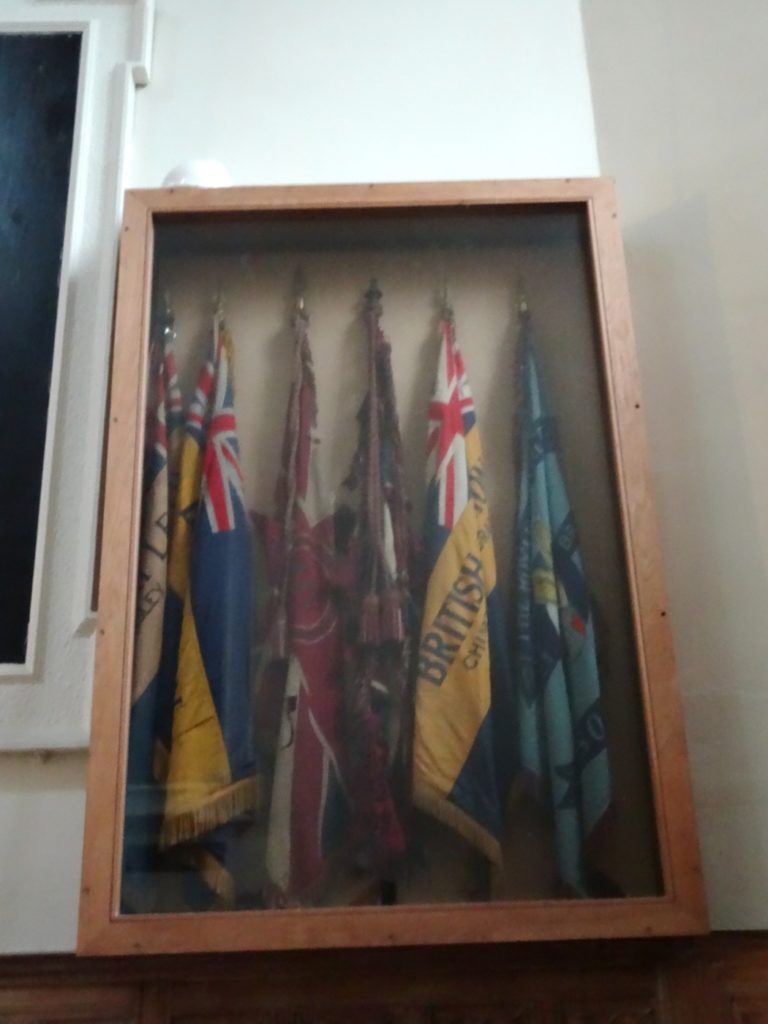
It seemed a pity that the Barnsley Pals’ Colours – unique and extremely important items of Barnsley Heritage – could not be seen very easily and my initial idea was just to clean the glass and promote their existence for the Somme Centenary. I discussed this with Father Stephen and I was delighted by his enthusiasm. I liked his idea about moving the ‘flags’ into the dedicated Memorial Chapel and I offered to carry out research to find out more about their history and any protocol.
It soon became apparent that it was going to be much more complicated than just cleaning the glass and that, to do things properly, we needed to have the Colours professionally inspected with a view to conservation.
I began by consulting various key individuals and organizations and was glad to have support from Sir Nicholas Hewitt, whose grandfather had been instrumental in forming the Barnsley Battalions as well as being the first Lieutenant-Colonel of the First Barnsley Pals. Goff Griffiths of the Royal British Legion, agreed with the idea of the Colours being conserved but not their Standards.
Once I had obtained obtain permission from the PCC to proceed with fundraising to pay for the accredited Conservation Unit at the People’s History Museum in Manchester to do an inspection of the Colours, I was then able to make an application to the Dearne Valley Landscape Partnership for grant funding. I am very grateful that DVLP agreed to pay £500, the bulk of the cost, as the first stage in this process.
Two textile conservators visited St Mary’s Church on 24 November 2016 to carry out a thorough inspection before writing up a report with options and estimates for preserving and displaying the Colours. Father Craig, the Curate at St Mary’s, was there all day, as was I, and other people visited at different times to provide practical assistance, to take advantage of the cupboard being open for the first time in many years to view the contents and to observe the conservators at work. Goff Griffiths, Joe Pinguey and other members of the British Legion who came along were fascinated by the three British Legion Standards laid up and it was the perfect opportunity to photograph them since they are obliged to allow them to ‘return to dust’. There was also an old RAF standard.
WHAT EXACTLY ARE THE COLOURS?
The Colours are of special significance for all soldiers and are used for identification, recording of battle honours and as a rallying point. They are consecrated before use and are symbolic of the duty of soldiers to their God, monarch and country. The phrase ‘join the Colours’ means to enlist in the Army. The Household Division of the British Army parades its Colours in front of the monarch in a ceremony called ‘Trooping the Colour.’ During the First World War, Army Battalions took their Colours overseas, marching proudly behind them, but did not carry them to the front line as they would have become targets.
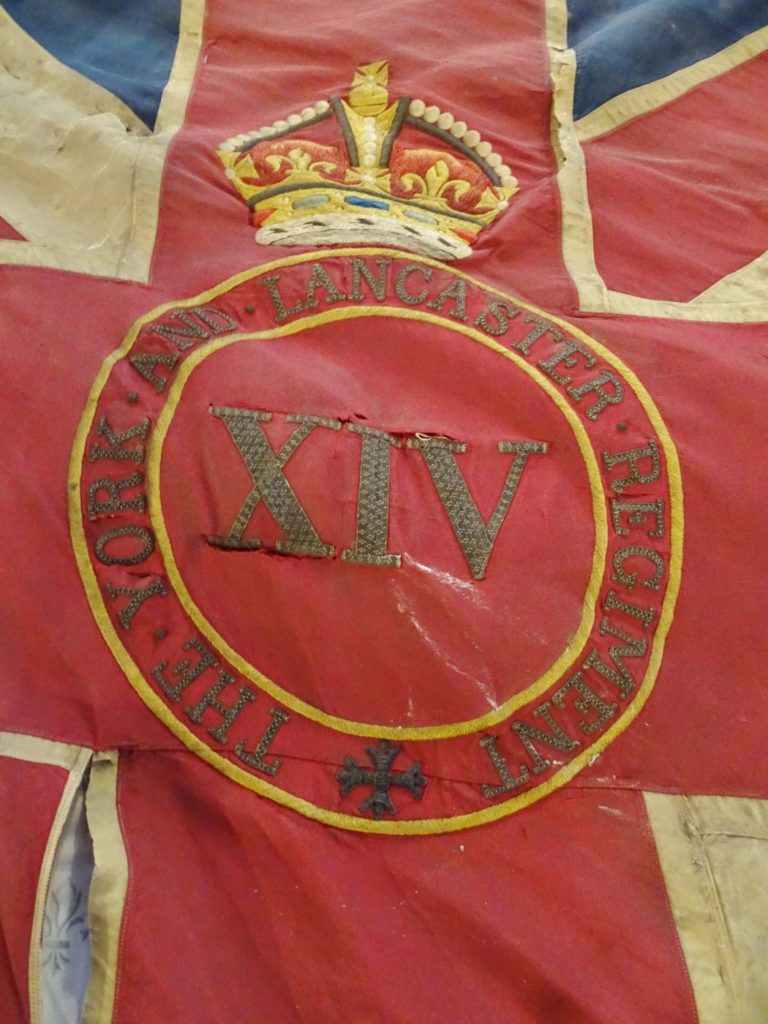
The Colours are traditionally ‘laid up’ in a Cathedral or Church, who assume ownership and responsibility for them when no longer needed and it is customary for them to be allowed to ‘return to dust’. However, some museums and other places have conserved them and put them on display.
Before they were formally accepted for Kitchener’s New Army by the War Office – as the 13th and 14th (Service) Battalions of the York and Lancaster Regiment (13YLR and 14YLR) – the Barnsley Pals were clothed, equipped and trained at the expense of the people of Barnsley, by fundraising and generous donations from benefactors. Each Battalion comprised about 1,000 men (Officers and Other Ranks).
Battalions usually had two ‘flags’ each with their individual King’s (or Queen’s) Colours – a unique insignia on a Union Flag – and Regimental Colours, but I discovered that there was only one each for the two Barnsley Pals in the cupboard in St Mary’s. I assumed that this was because the Pals were temporary for the duration of the war only and not part of the Regular Army. However, my further research has raised more questions about their history, which I want to find out more about before reporting further.
The 14YLR ceased to exist after the Somme Offensive of 1916 because of the number of men killed during that year and they amalgamated with the First Barnsley Pals and other Battalions of the York and Lancaster Regiment. The 13YLR continued until after the Armistice of 11 November 1918 and the troops were eventually demobilized months afterwards – part of the Army was needed until after the Peace Treaty was signed on 28 June 1919.
The Colours of the 13YLR were deposited in St Mary’s Church on 29 May 1919, according to a local newspaper article, which explained how a cadre of about 50 men had returned from the Army of Occupation in Germany to participate in this important ceremony. There were approximately 900 men amongst the crowds of people attending who had been discharged from the Barnsley Pals because of injuries and both of the original Lieutenant-Colonels, William Elmsley Raley now Mayor of Barnsley, and Sir Joseph Hewitt gave speeches. They acknowledged that honour was also due to the many thousands of Barnsley men who had served in the Territorials, Royal Engineers and other services and this would be observed when they had all returned home.
There was no mention at this time about the Colours of the 14YLR, which Thomas Fox had offered to donate in January 1915 – he was a local Wine Merchant and older brother of Charles Fox, who became Lieutenant-Colonel of the 1/5th Battalion of the York and Lancaster Regiment.
Barnsley Archivist Paul Stebbing alerted me to a collection related to this and I photographed some of the documents and images. A special ceremony took place on 8 April 1923 in which Earl Fitzwilliam presented King’s Colours that had been consecrated by the Bishop of Wakefield to the Second Barnsley Pals. They were taken that day to St Mary’s Church and deposited there for safekeeping. I have yet to ascertain if this was the flag donated by Thomas Fox.
I had initially understood that Battalions had two ‘flags’ each with their individual King’s (or Queen’s) Colours – a unique insignia on a Union Flag – and Regimental Colours, but there was only one each for the two Barnsley Pals – more accurately the 13th and 14th (Service) Battalions of the York and Lancaster Regiment (13YLR and 14YLR). I assume that this was because they were part of Kitchener’s New Army, which was created for the duration of the war only and was not part of the Regular Army.
The 14YLR ceased to exist after the Somme Offensive of 1916 because of the number of men killed during that year. The 13YLR continued until after the war ended in November 1918 and the troops were eventually demobilized months afterwards.
The Colours of the 13YLR were deposited in St Mary’s Church on 29 May 1919, according to a local newspaper article, which explained how a cadre of about 50 men had returned from the Army of Occupation in Germany to participate in this important ceremony. There were approximately 900 men amongst the crowds of people attending who had been discharged from the Barnsley Pals because of injuries and both of the original Lieutenant-Colonels, William Elmsley Raley now Mayor of Barnsley, and Sir Joseph Hewitt gave speeches. They acknowledged that honour was also due to the many thousands of Barnsley men who had served in the Territorials, Royal Engineers and other services and this would be observed when they had all returned home.
There was no mention at this time about the Colours of the 14YLR and I suspect that they must have been lost or destroyed in France after the Battalion was disbanded. The original Colours had been donated by Thomas Fox, Wine Merchant and older brother of Charles, who became Lieutenant-Colonel of the 1/5th Battalion (Territorials) of the York and Lancaster Regiment.
Barnsley Archivist Paul Stebbing alerted me to a collection related to this and I photographed some of the documents and images. A special ceremony took place on 8 April 1923 in which Earl Fitzwilliam presented King’s Colours that had been consecrated by the Bishop of Wakefield to the Second Barnsley Pals. They were taken that day to St Mary’s Church and deposited there for safekeeping. I have yet to ascertain if this was the flag donated by Thomas Fox.
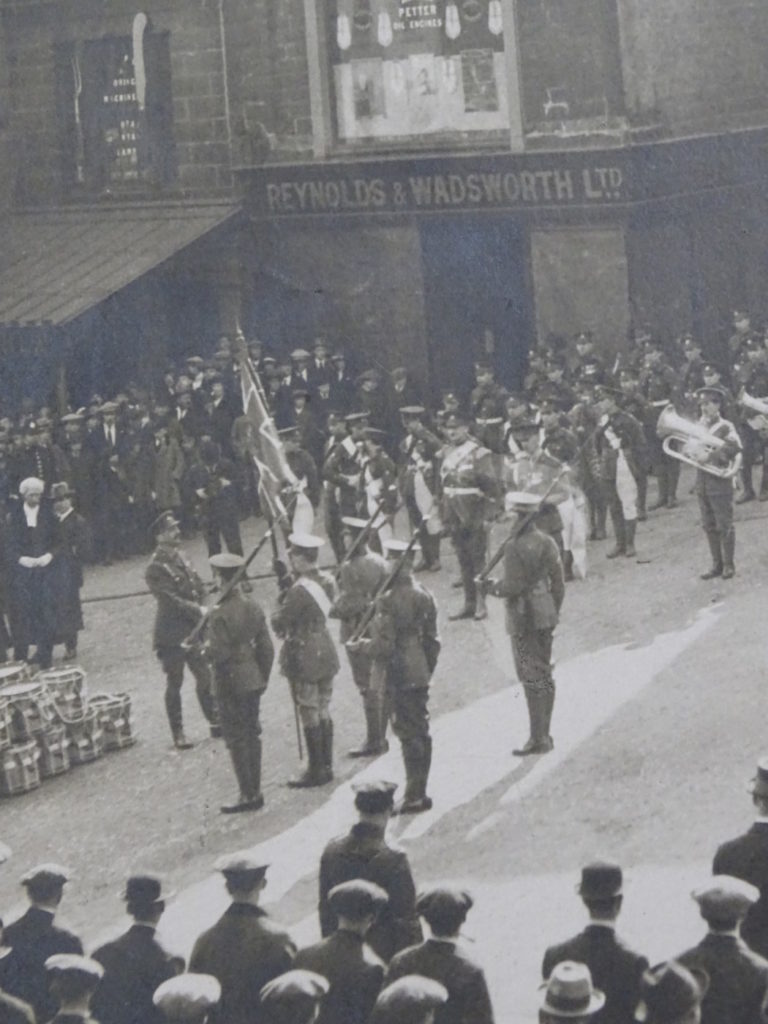
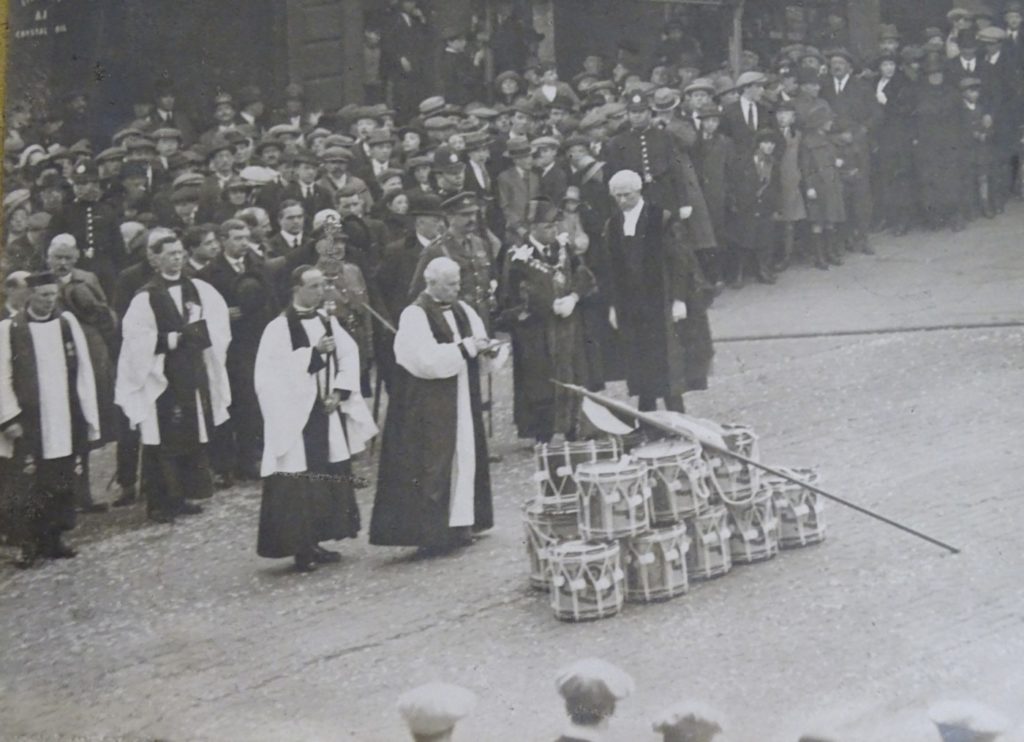
WHAT HAVE THE CONSERVATORS SUGGESTED?
The close inspection revealed the condition of the two Colours. One, which has no insignia to identify it but must belong to the First Barnsley Pals, is in very poor condition. The other belongs to the Second Barnsley Pals, identified by the numerals XIV and Regiment, and is in much better condition.

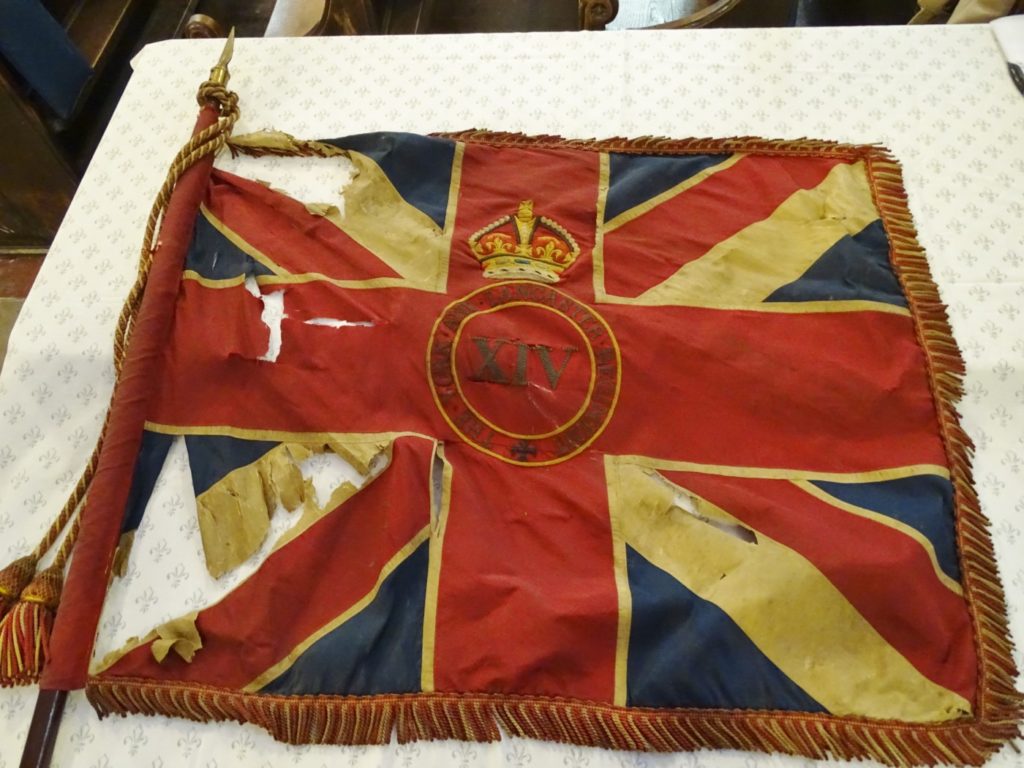
The conservators have recommended that once preserved they should be displayed flat in special frames to provide full protection for the future and to make them more visible. The cost of doing this will be approximately £13,000. There will be additional costs of hanging the frames when a decision has been made about the most suitable place for them.
WHAT HAPPENS NEXT?
I intend to carry out more research to resolve mysteries that have come to light so far. I hope, with the help of relevant individuals, to discover more about where and how they were displayed in the church and when they were put into the glass fronted cupboard with the other Standards. Equally, I would be thrilled to hear from any one who has any connection to either the 13YLR or 14YLR and would be happy to share their stories.
I will explore options for raising the funds necessary to conserve both Colours. The eventual location for displaying the frames will depend on the PCC and any requirements from the Church of England’s Architects as St Mary’s Church is listed Grade II. I am also investigating the possibility of commissioning reproductions, as was suggested to me, and these could have multiple uses.
I have recently discussed with Horizon Community College how they might be involved in this project. Tom West, Community Enterprise Team, is keen for them to work on a Timeline for Barnsley in the First World War and a town plan showing significant locations for the Pals, both of which will help to enhance the history of the Colours.
I will continue to involve and consult other key people and would welcome any input from others with an interest in this subject, especially anyone who might like to help with fundraising. I will keep people informed of progress via DVLP, Barnsley Chronicle and other media.
Jane Ainsworth
If you would like to contact me about any aspect of this project please email: [email protected] or contact the DVLP on 01226 772414, [email protected]
NB Unless otherwise credited all of the jpegs used in this blog are the copyright of Jane Ainsworth. My photographs of the images in Barnsley Archives are used here by their kind permission.
************************************
OTHER PROJECTS
I researched and wrote a memorial book about the 76 Old Boys of Barnsley Holgate Grammar School on the First World War Memorial and this includes a detailed history of the school. I donated my first version of this to the Cooper Art Gallery on 31 July 2014 to coincide with the centenary of the opening of the original school building as an art gallery as well as 100 years since the outbreak of the Great War. I gave an updated version to Barnsley Archives while continuing my research and a more comprehensive copy was published as Great Sacrifice by Helion & Company in March 2016. I consider this book my legacy to Barnsley and my ongoing interest in the Old Boys has provided the inspiration for my other First World War projects.
When I began researching the names on this War Memorial early 2013, I discovered that Barnsley did not have a Roll of Honour and, therefore, I decided to create one. I started compiling a list of War Memorials in the district, finding many that were not already on the Imperial War Museum’s website. I visited them to record details and donated my files and albums of photographs to Barnsley Archives on Remembrance Day 2013. I had soon realised that this was far too big a project for me to complete alone and I advertised for volunteers to help me, but it was only after I invited all the contacts I had made to a meeting in the Town Hall at the end of November 2013 that the Barnsley War Memorials Project was founded. BWMP were able to continue the work that I had begun.
I was aware of the large number of the Old Boys who had served on the Somme in 1916, many of whom had died during the offensive but others survived it to be killed in other actions. When I enquired towards the end of 2015 whether there would be a civic commemoration for the Somme Centenary, I was led to believe that none was planned since many ‘dignitaries’ were going to France for the commemoration at Thiepval. Having visited Silverwood Scout Camp while recording War Memorials and been impressed by their beautiful outdoor chapel, I decided to organise an event there on 1 July 2016. It was an ideal venue as it had originally been Newhall Camp where the Barnsley Pals were billeted and trained while in Barnsley. I was delighted that the Scout Volunteers supported my idea and allowed me to use the site free of charge since I had no funding for my event. I put on displays in the new Billingham Centre, where refreshments were available, and Horizon Community College, Silkstone Primary School and relations of some of the Old Boys contributed to the poignant Remembrance Service in the chapel.
*********************

